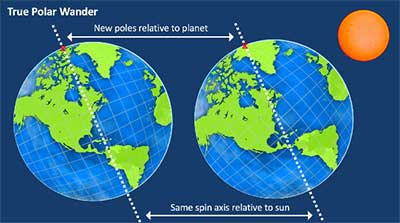A Shift in Earth’s axis due to Climate Change
According to a study published in Geophysical Research Letters of the American Geophysical Union (AGU) says that owing to enormous melting of glaciers since the rise of global temperature, our planet’s axis of rotation has been moving more than usual since the 1990s.
However this change is not noticeable in our daily life but it will definitely change the length of the day by a few milliseconds.
The Earth’s axis of rotation is the line along which it spins around itself as it revolves around the Sun. The points on which the axis intersects the planet’s surface are the geographical north and south poles.
The position of the poles is not fixed and it moves when the axis moves, and the movement is called ‘polar motion’.
The data from NASA of 20th century shows that the spin axis drifted about 10 centimetres per year means that in a century, polar motion exceeds 10 metres.
In general, polar motion occurs by changes in the hydrosphere, atmosphere, oceans, or Earth. But now, climate change is laying impact on change in axis degree as the poles are wondering.
New Research
Due to rise in global temperature melting of glaciers has caused Earth’s poles to drift in new directions. The north pole is noted to be shifted towards eastward direction.
The average speed of the drift was 17 times faster from 1995 to 2020, in comparison to that from 1981 to 1995.
The calculations of the drift was based on satellite data from NASA’s Gravity Recovery and Climate Experiment (GRACE) mission and also by estimate of glacier loss and groundwater pumping going back to the 1980s.
The other causes are shortage of land water in non‐glacial regions due to climate change and unsuitable consumption of groundwater for irrigation and other anthropogenic activities.
While ice melting is the major component behind increased polar motion, groundwater depletion also adds to the phenomenon. As millions of tonnes of water from below the ground is exhausted every year for drinking, industries or agriculture, most of it finally joins the sea, thus readjusting the planet’s mass.







